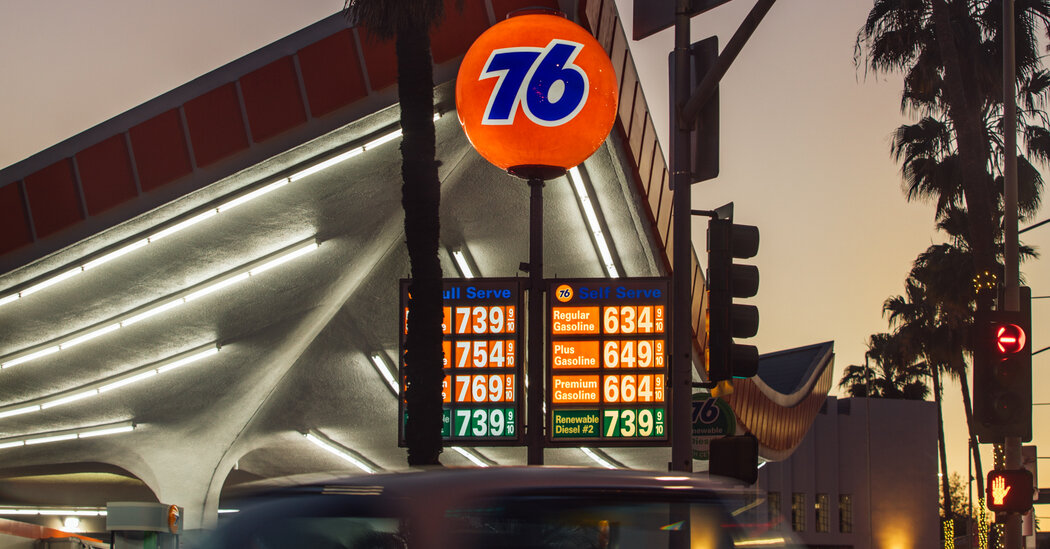The price of gasoline is climbing and the markets are adjusting to gloomier prospects as the war in Ukraine grinds on.
It’s getting to the point where you’re better off filling up your gas tank in the morning because the price will be higher by the time you drive home.
This is an exaggeration, but not much of one. The price of gasoline was already rising before Russia invaded Ukraine on Feb. 24, and it has risen every day since then. As the most important measure of inflation that most Americans regularly see, this daily increase is a big problem in itself.
But it’s more than that: It’s a tax on working people, a drag on economic growth and a conspicuous emblem of the acute problems afflicting a range of financial assets, from stocks and bonds to commodities like gold, nickel and wheat.
These issues are minor compared with the anguish that the Russian onslaught has inflicted on Ukrainians. But it’s worth noting that both Russia’s brutal invasion as well as Western efforts to counter it and aid Ukraine are spilling over into global financial markets, affecting, in ways big and small, virtually everyone in the United States and around the world.
Prices at the pump
Consider that since the Russian invasion, the average price of regular gas in the United States had increased 17 percent through Wednesday. It was up 23 percent from the beginning of the year.
On Tuesday alone, the average price of a gallon of regular rose 8 cents, to $4.25 from $4.17 according to statistics compiled by the AAA motor club, and it’s much higher in states like California, where a gallon of regular cost $5.57, on average. For a variety of reasons, the price in many communities is much steeper than that.
More price increases, and big ones, are already inevitable.
Gasoline prices are based on the cost of crude oil, which jumped in response to the invasion and Western sanctions. With the announcement on Tuesday that the United States and Britain would ban imports of Russian energy, the climb in world oil prices appeared to be far from over.
Where oil prices go, wholesale and retail prices for gasoline eventually follow, as Paul Ashworth, chief U.S. economist for Capital Economics, explained in an interview on Monday. Even if the price of oil went no higher, the average price of retail gas in the United States would reach $4.50 a gallon by April, he said.
“That’s just the way the markets work,” he said. Further increases seem likely.
In fact, after the American and British announcements, Mark Zandi, chief economist of Moody’s analytics, said on Twitter on Tuesday that he expected world oil prices to rise to $150 a barrel — an increase of more than 20 percent — “at least for a few weeks until things begin to sort out.” That would translate to about $5 for a gallon of regular unleaded gasoline, on average.
Current gasoline prices already surpass the previous records, which were set in the summer of 2008, if you don’t account for inflation. If you do take inflation into account, the picture isn’t very comforting, either. In July 2008, it cost roughly $5.35 for a gallon of regular in today’s money. Remember what happened next? Two months later, Lehman Brothers collapsed, helping to set off a global financial crisis, a stock market crash and a severe recession.
Gasoline and oil prices were not the immediate causes of those calamities but, as James D. Hamilton, professor of economics at the University of California, San Diego, concluded in a paper in 2009, they “made a material contribution” to the recession.
A regressive tax on working people
Price increases for gasoline and other basics are already hurting people with tight budgets who must drive to work or school — and who can’t cut back on food purchases.
Yardeni Research, an independent economic and stock market consultant, estimated that the average American household would spend roughly $3,100 on gasoline in 2022, based on price levels in December 2021. The price increases since then mean that households would have to pay about $2,000 more.
That’s not a big deal if you’re wealthy or if you own an electric vehicle. But for many working people, it’s equivalent to a tax.
“A lot of people have little choice,” Mr. Ashworth of Capital Economics said. “They have to drive.”
In addition, food prices have been increasing. Russia and Ukraine accounted for 28 percent of the global wheat trade and 18 percent of corn exports last year. The futures price of wheat has risen 36 percent this year and 27 percent since the war started on Feb. 24.
The story is similar for corn, barley and sunflower oil, commodities for which Russia and Ukraine are major players. Shipments through Black Sea ports have been obstructed, financial sanctions are limiting trade — and futures prices are spiking.
This is beginning to translate into food inflation in the United States — and quite possibly into a hunger crisis around the globe in the months ahead.
In the United States, Yardeni Research estimates, the average household will have to spend $1,000 more on food this year, given the difference between price trends now and in December 2021.
Combined, those increased costs for food and gas this year could amount to about $3,000. They have the effect of a hefty tax, one that’s extremely regressive, in that it hits lower-income people much harder than the rich.
Headaches for the Fed
This creates additional challenges for the Federal Reserve, which already has plenty of them.
Inflation has been running hot for a while. The Consumer Price Index for February, which is to be released on Thursday, is likely to be even higher than the 7.5 percent annual rate that was reported last month.
The spillover effects of the war will probably result in a high inflation reading next month as well. After that, year-over-year comparisons with high inflation caused in large part by supply-chain disruptions during the pandemic will start to make the inflation numbers look better.
The Russia-Ukraine War and the Global Economy
Rising concerns. Russia’s attack on Ukraine has started reverberating across the globe, adding to the stock market’s woes and spooking investors. The conflict could cause dizzying spikes in prices for energy and food, and severely affect various countries and industries.
But if commodity prices keep rising, the inflation numbers won’t go down rapidly as I, and many economists, had thought only a month ago. So the Fed will remain under considerable pressure to begin raising interest rates at its meeting next Tuesday and Wednesday. Higher interest rates could slow the economy.
At the same time, price increases and reductions in consumer spending imposed by the war are likely to be a drag on the economy. With the combination of rising interest rates and an oil shock, two unpleasant words are coming back into circulation: stagflation and recession.
They are just possibilities, but worries about them are weighing on the markets.
Stock and bond markets in disarray
Yields on long-term bonds have fluctuated, suggesting the markets have little conviction about where the economy is headed.
If the Fed does raise rates, it won’t take much for short-term interest rates to exceed the level of long-term ones — which would be another bad omen for the economy. Such a juxtaposition of interest rates, known as a yield curve inversion, has often preceded recessions.
The broad stock market has gotten off to one of its worst starts since 1900, Bloomberg records show. The markets are swinging up and down. But already this year, the S&P 500 has been down more than 10 percent from its peak, a drop known on Wall Street as a correction, while the Nasdaq composite has been more than 20 percent below its November peak, putting it into what Wall Street calls bear market territory.
Commodity bets have paid off. The iShares S&P GSCI Commodity-Index Trust, an exchange-traded fund that tracks a diversified group of commodities, is up 51 percent this year. Energy stocks have soared, but little else has done well.
For long-term investors with balanced, diversified portfolios containing stocks and bonds, declines like this occur periodically. They can be painful, but if history echoes itself, the stock market will recover and surpass its past highs.
If the effective closing of Russian financial markets and rising commodity prices lead to a steeper stock market decline, or have other, unexpected consequences, the Fed will be in a tough place. It is moving toward tightening monetary conditions but might have to reverse itself and engage in another rescue operation, as it did in March 2020.
This is a risky moment, as Liz Ann Sonders and Kevin Gordon of Charles Schwab said in a note on Monday. It’s conceivable that the war could end abruptly, and energy prices could sharply decline, but “betting on that in the near term seems a fool’s errand.”
It’s remarkable that in March 2022, decades after the oil shocks of the 1970s and the fall of the Berlin Wall, we’re worrying about oil and gas prices and a renewed Cold War, and not focusing on combating climate change and ending the pandemic. But to return to those concerns, we will have to get past the Russian war.




























